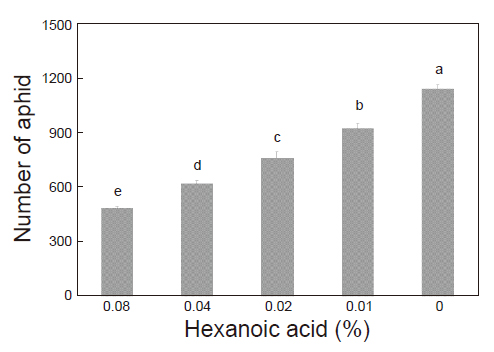All issues

Author:Yaw-Jen Dong and Bei-Chen Hsiu*
Abstract:
Treatment of plants with hexanoic acid has been shown to induce plant defense against microorganisms. Responses of plant to hemipteran herbivores have substantial overlap with responses mounted against microbial pathogens. In this research, we studied the effects of hexanoic acid treatments of cucumber plant on cotton aphid (Aphis gossypii Glover) population growth. Results showed that significantly lower cotton aphid numbers were found on cucumber plants grown from seeds soaked in hexanoic acid solution treatments or irrigated with hexanoic acid treatment than control and the effect increases with increasing concentration of hexanoic acid. Spraying cucumber plants with 0.04% and 0.08% hexanoic acid resulted in significantly reduced cotton aphid population growth than control. Besides 0.08% hexanoic acid volatile treatment, there was no difference of cotton aphid population growth between other hexanoic acid treatments and control. In summary, results of our research showed that hexanoic acid could reduce cotton aphid population growth on cucumber plants but the effect varied with concentrations and treatment methods.
Key words:Hexanoic acid, Cucumber, Cotton aphid, Induced resistance
Download:![]() PDF Links
PDF Links
- 1. Development of Tractor-Mounted Seedling Transplanter for Sweet Potato
- 2. Synergistic Effect of Additional Gas on the Toxicity of Phosphine to Sitophilus oryzae and Sitophilus zeamais (Coleoptera: Dryophthoridae)
- 3. Effects of Temperature and Solar Radiation on Growth Traits and Plant Elements in Purple Leafy Sweet Potato
 Submit your manuscript
Submit your manuscript
 Guide for authors
Guide for authors